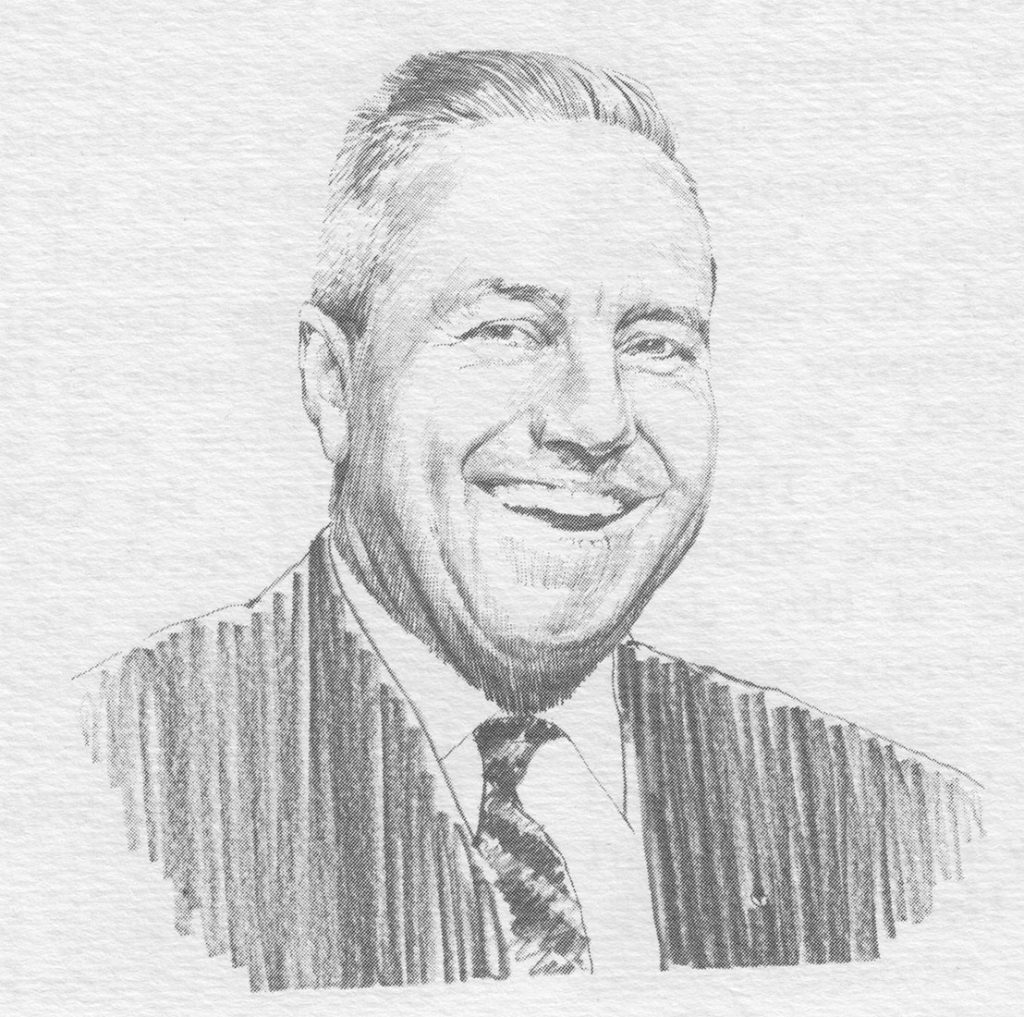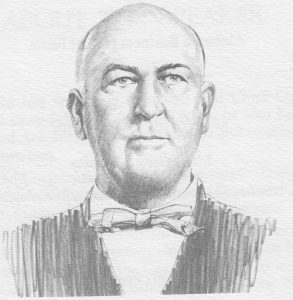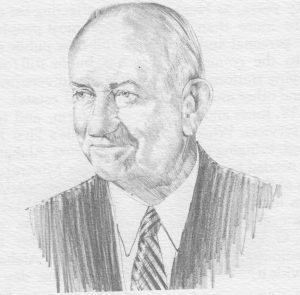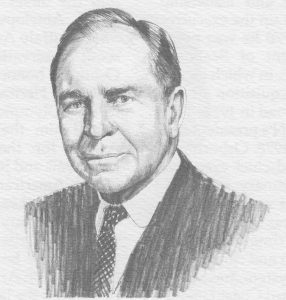Carl Tannahill Jones was a man of vision. Everywhere he looked, he saw the potential for progress. He saw it in his state. He saw it in his region. And most of all he saw it in his own hometown. As mentor, guide, organizer, benefactor, and chief cheerleader, Carl T. Jones spent his life helping transform a sleepy cotton mill town in North Alabama into an internationally-known space center and thriving industrial community. “Mister Huntsville,” many called him, and no one deserved the title more.
Dedication to one’s community and confidence in its future was not uncommon characteristics in the family from which he came. Great-grandson of one of Madison County’s earliest white settlers (Isaac Criner), Carl was the last of six children, and the youngest of five sons, born to Elvalena (Moore) and George Walter Jones. The elder Jones, a farmer, a civil engineer, a state senator, and a leader in Huntsville’s city government, also found time, in 1886, to establish an engineering firm that still prospers today. From its inception, G. W. Jones and Sons, as the enterprise was called, concerned itself with the welfare of the community. When the city coffers were bare (as they frequently were), when Huntsville could not afford to buy so much as a bale of hay on credit for its mules, when work performed for the city was not compensated at all, G. W. Jones and Sons stepped in and lent a hand. And the policy set by the father of serving the city on almost an “at cost” basis was continued by the sons, all of whom at one time or another joined the firm.
Carl T. Jones joined the firm in 1929, the same year he graduated in engineering from The University of Alabama, and from 1929 until 1960 he served as Huntsville’s city engineer. During those years, Huntsville experienced dramatic changes: it survived a great depression, played its part in winning a world war, became a key component in the U.S. space program, and transformed itself into one of the most energetic industrial communities in Alabama. Carl Jones had a hand in it all.
A colonel in the Alabama National Guard Combat Engineers when World War II broke out, Jones served in Alaska and the Aleutian Islands, and as deputy chief of staff of the XIX Corps in Europe, he participated with distinction in the Normandy landings and in combat operations on the European front.
Returning to Huntsville after the war, Jones found that the city and the times had changed. There was a sense of optimism in the air and a thirst for progress. Before his feet were firmly replanted in Huntsville soil, a group of businessmen from South Huntsville sought his help in expanding the city limits. Despite the fact that the city then consisted of less than four miles and was actually smaller than it had been before the Civil War, there was opposition to expansion and change. Carl Jones did what he was to do repeatedly throughout his lifetime; he talked to people, explained what the future could hold, and then quietly set an example for others to follow by donating his own engineering services to the project. As a result, the first major expansion in Huntsville’s city limits occurred in 1947, and a pattern of orderly growth was established.
During the next twenty years, as Huntsville’s land area grew to more than 100 square miles, Carl Jones’ personal and professional contributions to the community grew as well. When pumping stations, utility systems, reservoirs, and other municipal projects were needed, G. W. Jones and Sons provided the engineering services. When the U.S. space program arrived, bringing with it thousands of people who needed homes and city services, the firm was at the forefront of the expansion. And when local authorities needed data to plan some of their more ambitious public projects, G. W. Jones and Sons, with Carl Jones as senior partner, used the firm’s resources to provide it.
Jones’ confidence in the free enterprise system, his unwavering belief in Huntsville’s potential, and his infectious enthusiasm for an expansive idea made him an ideal leader. In 1957, when a textile manufacturing plant in Huntsville closed, Jones saw possibilities for the future. He organized (and later served as president for five years) Huntsville Industrial Associates, Inc., a group of business and professional leaders, who purchased the property in hopes of attracting other industries to the area. Although regarded by many as a bad investment at the time, the old mill complex was soon transformed into the Huntsville Industrial Center. At its peak, the facility housed some 6000 aerospace employees and had a payroll in excess of $30 million.
Jones also founded the Huntsville Industrial Expansion Committee, in which he served as a board member for many years and for three terms as president. Recognizing that federal spending on space programs would one day decline and that the economic health of the region depended upon diversified economic development, Jones intensified his efforts to bring new industries to the area. Largely as a result of his leadership, Huntsville succeeded in diversifying its economic base, and as a consequence, the region did not suffer when the inevitable federal cutback in space funding finally occurred.
Because he served almost every civic organization in Huntsville as either a member or a director or as president, and because he had a hand in every major decision affecting the city for a period of twenty years, most people thought of Carl Jones as a full-time public servant. In many ways he was, but he still found time to head the family’s now diversified firm (engineering/insurance/ real estate), to manage a 10,000-acre cattle farm, and to serve on the boards of Huntsville’s First National Bank (predecessor of First Alabama Bank) and the North Alabama Mineral Development Company. And he never stopped looking to the future.
Recognizing early on the value of a university to the region, Jones worked tirelessly to further the development of the University of Alabama in Huntsville, believing that one day that institution would become the area’s foremost economic unit.
Although Carl Jones never sought the limelight and many of his civic contributions were never publicized, the citizens of Huntsville knew what his vision and his years of service had meant to their community, and they publically honored him on several occasions. In 1965 the region’s chamber of commerce presented him its “Distinguished Citizen Award,” and in 1967 the multi-million dollar Huntsville-Madison County Jetport – a symbol for many of the region’s progressive spirit and its confidence in the future – was named Carl T. Jones Field. It was an especially fitting tribute to a man who had himself become a symbol of that same public spirit and confidence.
Carl Jones did not live to see the jetport completed, nor to see it named in his honor. His untimely death at the age of 58 shocked and saddened an entire community that had come to regard his vision and his leadership as indispensable. Editorials were written about his contributions, and tributes poured in from around the state. He was, said the eulogists, a man who had led the way when the path was not clear, a man who had done more for his community in his fifty-eight years than most people could accomplish in several lifetimes. He was, they all agreed, the father of the region’s industrial expansion, and no one would ever deserve the title “Mister Huntsville” more.





